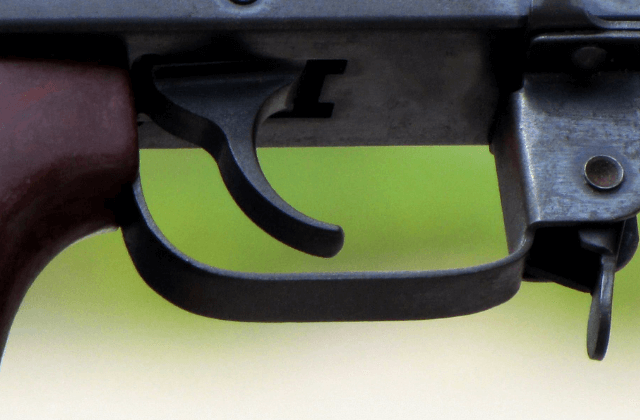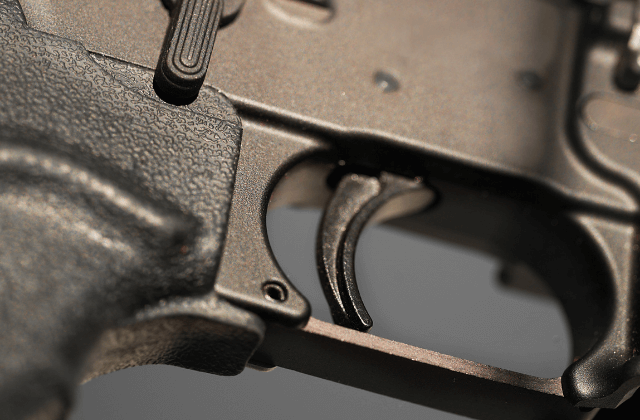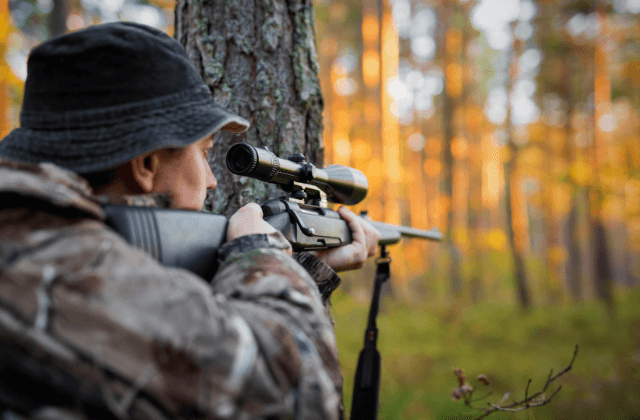This site contains affiliate links. As an Amazon Associate, I earn a commission from qualifying purchases at no extra cost to you. Full Disclosure Here.
Binary triggers are a hot-button topic right now, so we wanted to provide a little more info on these lead-slinging little beauties. Binary triggers seem like a lot of fun, but are they worth the expense? Do they offer any practical benefit, or are they just a range toy?
We’ve tested these little gizmos extensively in order to give an accurate and honest opinion, and what we found surprised us. I’ve tested quite a few triggers in my day and shot quite a few true full-auto guns, but the binary triggers I tried definitely felt like something completely different.
Let’s take a deeper dive into binary triggers so you can decide if they’re something worth adding to your arsenal.
What is a Binary Trigger?
A binary trigger functions similarly to the AR triggers you’re familiar with, but it has a secondary firing mode, not unlike a fully-automatic (select fire) firearm like an M4 or MP5.

Unlike those triggers, which have safe, semi-auto, and full-auto as options, a binary trigger has safe, semi-auto, and binary fire. Safe, semi-auto, and full-auto, you’re probably familiar with, but what exactly is binary fire?
Binary fire triggers work by firing a round when the trigger is pulled as normal and firing another round when the trigger is released. This effectively doubles the rate of fire of a semi-automatic gun.
There are some problems with that and some practical considerations to keep in mind, but that’s the basics of binary triggers.
How Does a Binary Trigger Work?
To begin with, it’s important to fully understand how a standard semi-auto trigger works. When a semi-auto trigger is pulled to the rear, a sear is released, allowing the hammer to go forward. The hammer then hits the firing pin, which ignites the primer and fires the round.

After the round is fired, the reciprocating bolt carrier resets the hammer. As your finger releases the trigger, the sear re-engages the hammer and you’re ready to fire again by pressing the trigger again.
With a binary trigger, you have two separate sears that trade off the duty of holding the hammer back. One is released by pulling the trigger back as normal, at which point the gun fires, the hammer resets, and then the second sear catches the hammer.
This second sear releases the hammer when you release the trigger, firing the gun again.
You can interrupt this sequence by switching to semi-auto or safe in any binary trigger worth owning, so you don’t have to fire the second shot, but other than that, the gun will fire each time you press and release the trigger when in binary mode.
This increases an average shooter’s fire rate, especially compared to a standard mil-spec semi-auto trigger.
The downsides are the extra mechanical complexity makes it harder to get a really smooth action out of a trigger like this, and the fact that some binary triggers can outrun the bolt carrier, which can cause the binary fire mode not to function properly.
That said, once you get some practice in, these things rarely cause problems and when they do, they’re pretty easily dealt with.
Installing the trigger is also fairly straightforward and will generally be a breeze for anyone who has built an AR-15 lower before or anyone with some basic DIY-type skills and the ability to follow along with a YouTube video.
Why Use a Binary Trigger?
There are several applications that make use of a binary trigger to varying degrees of success. We’re going to take a look at the most common shooting scenarios and see how helpful a binary trigger would be.
Binary Triggers For Hunting
First up, hunting. To be perfectly honest, this is an area where a binary trigger really isn’t going to offer you much benefit. Nearly all hunting situations involve one carefully placed shot, with the goal of ethically bringing down an animal as soon as possible.

Because of their design, binary triggers tend to be less accurate in semi-auto mode due to the extra mechanics introducing slop and grit into the trigger pull. These triggers aren’t exactly smooth precision rifle triggers.
Beyond that, the only real use for the rapid-fire option would be some kind of defensive shooting, like if a bear attacked you, or just trying to eliminate a pest species like feral hogs.
In other words, not the best option for hunting.
Binary Triggers For Self-Defense
When it comes to self-defense, things look better. Of course, very few self-defense situations in the United States call for suppressive fire. Unless you’re in Somalia or the DRC, this isn’t something you need.
That said, there is theoretically a use for rapid-fire from something like a binary trigger.
In defensive/tactical shooting, we have a “hammer pair,” which is simply two shots fired so rapidly that you don’t acquire a sight picture for the second round fired. You’re essentially aiming using the sight picture acquired for the first and ignoring the small deviation because of recoil.
A binary trigger can make this easier, provided you train with them. Does it make it easier than, say, a rapid-fire competition trigger? Maybe not, but it is an advantage over a standard mil-spec trigger, even if it’s not optimal.
Speaking of competition triggers…
Binary Triggers For Competition
In theory, some competition events can be made a little easier with a binary trigger…and that’s why many competitions ban them. Rapid fire strings are noticeably faster with a binary trigger, so events that require multiple hits quickly can be “gamed” with a binary trigger.

And for that reason, most competitions where having a binary trigger would give you a noticeable advantage have banned them. For the ones that haven’t, you’d be better off with a smoother single-stage trigger or 3-Gun style trigger that will be more accurate and consistent.
Binary Triggers For Target Shooting/Plinking/Having Fun
Lastly, we come to the area in which a binary trigger really shines: just having fun shooting.
It’s so easy to become bogged down in what the most tactical/practical thing to do is with a gun, but the truth is, not everything about your gun or gun collection has to be practical. It’s perfectly fine to have guns or accessories that just bring you joy.
Some of the stuff out there can be a little cringey, don’t get me wrong, but when it comes to something like a binary trigger? There’s nothing wrong with having (safe) fun!
If you’re looking for something that will make your range trips more enjoyable and be a good time to shoot, then a binary trigger is a fantastic addition to your gun. This simple upgrade adds a whole new dimension to your shooting and can turn a standard range trip into something truly memorable.
I’ve yet to see an average Joe or Jane shooter at the range use a binary trigger (or a real full-auto gun) at the range and not have a smile on their face afterward. Grinning, chuckling, and sometimes full-on Super Villain-esque cackling are the typical responses.
I own entire firearms that live in my safe purely because they bring me joy. I don’t hunt with them or compete with them, and they wouldn’t be the first thing I grabbed in the event of a home/alien invasion.
But they accompany me to almost every range trip where I’m going just to have fun, shoot some targets, and turn money into noise and gunsmoke.
Shooting guns is just plain fun, and I think it’s okay that we, as gun owners admit that. If you’re looking to amp up your fun at the range and don’t want to go all in on a transferable full-auto gun that will cost you tens of thousands of dollars plus months to years of waiting on forms to process, then a binary trigger is a great option.
Check out this article on 10 Best Ruger 10/22 Upgrades.
Should You Use a Binary trigger?
At the end of the day, it’s up to the legality of where you live and your personal feelings. Obviously, we recommend you follow all local and state laws, as well as any federal regulations, so make sure to keep on top of those and keep yourself legal. If you aren’t sure, ask a lawyer, not us.

Many states that take a dim view towards firearm ownership, in general, have either already banned these triggers or have bills working their way through the legislature to do so.
Beyond that, binary triggers are a tremendous amount of fun and a great additional feature to have on your gun at the range, so if you think the investment is worth it, then absolutely go for it!
Not every firearm collection aspect must be about tactical/practical upgrades and performance. Many of us have firearms we enjoy shooting, and that’s our sole purpose in life. Even if fun, casual shooting at the range isn’t your primary goal for a gun, it can still be a goal.
There’s no reason why you can’t have a gun or accessory that is just there to make you smile, and I promise a binary trigger will absolutely do that.
Frequently Asked Questions
Very few factory guns come with a binary trigger. Some of the most common ones come from binary trigger pioneer Franklin Armory. Their BFS rifles come with binary triggers preinstalled from the factory.
A binary trigger doesn’t provide a huge benefit for anything other than having fun at the range, and performance in other, more common areas can suffer. If having fun with your gun is important to you, though, they’re absolutely worth the money, however, they can provide some tactical benefits if you train with them.
In most states, yes. At the time of writing, binary triggers are not federally banned, so anyone can own one if they aren’t prohibited in their state and they’re willing to spend the money. However, they are illegal or restricted in several states, so check your local laws.
Conclusion
In this article, we walked you through what a binary trigger is and how many uses there are for it. They may not be built for hunting or self defence, but are great for competitions. Unfortunately, they’ve been banned from being used there as well. As we’ve discovered, binary triggers are best for when you want to have a little fun with your firearm.
All this aside, you should always make sure that you follow your state’s regulations in terms of firearms and binary triggers.
Binary triggers are relatively simple devices that have become shrouded in a level of mystery and misinformation, but hopefully, we’ve been able to clear the air.

